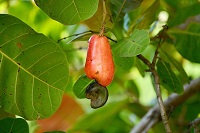Toxicity Screening and Hypocholesterolemic Effect Evaluation of Aqueous Extract of Anacardium occidentale Linn. in Hypercholesterolemic Induced Rabbits
Keywords:
Toxicity Screening, Hypocholesterolemic, Anacardium occidentale Linn.Abstract
Previous findings have supported to the ethnopharmacological use of Anacardium occidentale Linn. in folk medicine. In this study, the toxicity properties and the hypocholesterolemic effect of aqueous extract of Anacardium occidentale Linn. were evaluated in hypercholesterolemic induced rabbits. Thirty Five male New Zealand White Rabbits were randomly assigned into five groups and fed with normal diet (NC), 0.5% high cholesterol diet (PC), 0.5% high cholesterol diet+10 mg/kg simvastatin (SC), 0.5% high cholesterol diet+100 mg/kg AOE (AOE100) and 0.5% high cholesterol diet+200 mg/kg AOE (AOE200). The study duration was set for 12 weeks. In vitro toxicity study has been performed using brine shrimp lethality test and MTT assay to determine the LC50 and IC50 values respectively while in vivo toxicity study has been evaluated in hypercholesterolemic induced rabbits. Blood samples were withdrawn at week 0 and 12. Supplementation of 0.5% high cholesterol diet caused the elevation of TC, LDL and TG and also significantly rise (p<0.05) the level of liver enzymes compared to the normal control group. For in vitro toxicity screening, extracts demonstrated very low LC50 values and no IC50 value detected. For in vivo hypercholesterolemic induced rabbits, extracts were able to prevent the increment of liver enzymes: gammaglutamyl transferase, alkaline phosphatase, aspartate aminotransferase and alanine aminotransferase compared to positive control group. Aqueous extract of AO found to be not toxic and posses hypocholesterolemic and hepatoprotective effects in hypercholesteromic induced rabbits.
References
Garjani A, Fathiazad F, Zakheri A, et al.
The effect of total extract of Securigera
securidaca L. seeds on serum lipid profiles,
antioxidant status, and vascular function in
hypercholesterolemic rats. J
Ethnopharmacol. 2009;126:525–532.
Konan NA and Bacchi EM. Antiulcerogenic
effect and acute toxicity of a hydroethanolic
extract from the cashew (Anacardium
occidentale L.) leaves. J Ethnopharmacol
(2007) 112:237–242
De La Lastra, Alcatron C, Martin MJ, et al.
Antiulcer and gastroprotective effects of
quercetin: a gross and histologic study.
Pharmacology. 1994;34:2477–2482.
Sniderman AD. Is there value in liver
function test and creatine phosphokinase
monitoring with statin use? Am J Cardiol.
;94:30F–34F.
Homolka J. Clinic Biochemistry. Prague.
:House SZN. pp 434.
Young TA, Tang HS, Lee HS, et al. Effects
of hyperglycemia on quantitative liver
functions by the galactose load in diabetic
rats. Metabolism. 2007;56:1265-1269.
Blahovec J and Slesarova L. Enzyme and
Clinic Enzymology. Slovak. 1991: ZENIT
Press. pp. 127.
Ogunkeye OO and Roluga AI. Serum
cholinesterase activity helps to distinguish
between liver disease and non-liver disease
aberration in liver function tests.
Pathophysiology. 2006;13:91–93.
Solis PN, Wright CW, Anderson MM, et al.
A microwell cytotoxicity assay using
Artemia salina (brine shrimp). Planta
Medica. 1993;59:250-252.
Chen XL, Zhang Q, Zhao R, Medford RM.
Superoxide H2O2 and iron are required for
TNF- induced MCP-1 gene expression in
endothelial cells: Role of Racl and NADPH
oxidase. Am J Physiol Heart Circ Physiol.
;286:1001-1007.
Takahashi S, Abe T, Gotoh J, Fukuuchi Y.
Substrate-dependent of reduction of MTT:
A tetrazolium dye differs in cultured
astroglia and neurons. Neuchem. Int.
;40:441-448.
Meyer BN, Ferrigni NR, Putnam JE, et al.
Brine shrimp: A convenient general
bioassay for active plant constitiuents.
Planta Medica. 1982;45:31-34.
Mbwambo ZH, Moshi MJ, Masimba PJ, et
al. Antimicrobial acticity and brine shrimp
toxicity of extracts of Terminalia browni
roots and stem. BMC Complem Altern M.
;7:9-14.
Tedong L, Dzeufiet PDD, Dimo T, et al.
Acute and subchronic toxicity of
Anacardium occidentale Linn.
(Anacardiacea) leaves hexane extract in
mice. African Journal of Traditional,
Complementary and Alternative Medicines.
;4:140-147.
Prasad K. Hypocholesterolemic and
antiatherosclerotic effect of flax lignan
complex isolated from flaxseed.
Atherosclerosis. 2005;179:269-275.
Ishida F, Sato A, Iizuka Y, et al. Effects of
MK-733 (simvastatin), an inhibitor of 3-
hydroxy-3-methylglutaryl coenzyme A
reductase, on intestinal acylcoenzyme A:
cholesterol acyltransferase activity in
rabbits. Biochimica et Biophysica Acta
(BBA) - Lipids and Lipid Metabolism.
;1004:117-123.
Corsini A, Bellosta S, Baetta R, et al. New
insights into the pharmacodynamic and
pharmacokinetic properties of statins.
Pharmacology and Therapeutics.
;84:413-428.
Bassumillik AK. Changes in serum lipid
profile in atherosclerotic rats on feeding
guava pulp and isabgol (Plantago ovata
Forsk.) powder. Pathophysiology.
;1:113-116.
Prasad K. Dietary flax seed in prevention of
hypercholesterolemic atherosclerosis.
Atherosclerosis. 1997;132:69-76.
Mohamedein MM and Kummerow FA.
Cholesterol-rich diets have different effects
on lipid peroxidation, cholesterol oxides,
and antioxidant enzymes in rats and rabbits.
J Nutr Biochem. 2000;11:293-302.
Mathews CK, van Holde KE and Ahern
KG. Lipid metabolism 1: Fatty acids,
triacylglycerols and lipoproteins. In:
Biochemistry. Addison Wesley Longman.
;pp. 350-356.
Harrison D, Griendling K, Landmesser U,
et al. Role of oxidative stress in
atherosclerosis. Am J Cardiol. 2003;91:7A–
A.
Carr AC and Frei B. Toward a new
recommended dietary allowance for
Vitamin C based on antioxidant and health
effects in humans. Am J Clin Nutr.
;69:1086–1107.
Demirdag K, Bakcecioglu IH, Ozercan IH,
et al. Role of L-carnitine in the prevention
of acute liver damage induced by carbon
tetrachloride in rats. J Gastroen Hepatol.
;19:333–338.
Lin SC, Yao CJ, Lin CC, et al.
Hepatoprotective activity of Taiwan folk
medicine: Eclipta prostrate Linn. against
various hapatotoxins induced acute
hepatotoxicity. Phototherapy Research.
;10:483–490.
Ram A, Lauria P, Gupta R, et al.
Hypocholesterolaemic effects of Terminalia
arjuna tree bark. J Ethnopharmacol.
;55: 165-169.
Ochmanski W and Barabasz W Aluminiumoccurrence and toxicity for organisms.
Przeglad Lekarski. 2000;57:665–668.
Rahman MF, Siddiqui MK and Jamil K.
Acid and alkaline phosphatase activities in a
novel phosphorothionate (RPR-11) treated
male and female rats. Evidence of dose and
time-dependent response. Drug and
Chemical Toxicology. 2000;23:497–509.
Murata C, Watanabe T, Furuya H, et al.
Aldehyde dehydrogenase 2 and 3-
adrenergic receptor gene polymorphisms:
Their association with elevated liver
enzymes and metabolic syndrome.
Metabolis. 2003;52:1096-1101.



